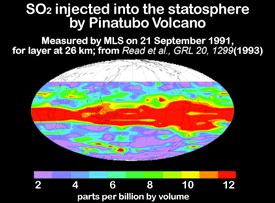Microwave Limb Sounder
→ → →
About MLS
MLS uses microwave emission to measure stratospheric temperature and upper tropospheric constituents. MLS also has unique capability to measure upper tropospheric water vapor in the presence of tropical cirrus, and also the cirrus ice content. These measurements are valuable for diagnosing the potential for severe loss of Arctic ozone when abundances of stratospheric chlorine will still be high, and slight cooling of the stratosphere could exacerbate ozone loss due to chlorine chemistry.
MLS is providing the first global measurements of OH, HO2 and BrO, constituents that play an important role in stratospheric chemistry. MLS is unique in its ability to provide these measurements in the presence of tropical cirrus, where important processes affecting climate variability occur. MLS also provides unique measurements of cirrus ice content.
The simultaneous MLS measurements of upper tropospheric water vapor, ice content, and temperature, under all conditions and with good vertical resolution, will be of great value for improving our understanding of processes affecting the distribution of atmospheric water, climate variability, and tropospheric-stratospheric exchange. The simultaneous measurements of dynamical tracers CO and N2O enhance the value of this data set by helping identify source regions of the air masses being observed.
MLS Science Objective
The overall scientific objective of MLS is to help improve understanding and assessment of :
Ozone Depletion
- Emphasis on the lower stratosphere
- Perform critical monitoring of the entire stratosphere
- During the period when ozone is most vulnerable to destruction by chlorine
Climate Change
- Emphasis on processes in the upper troposphere and lower stratosphere
- For both seasonal-to-interannual and long-term climate variability
Tropospheric Ozone
- Distribution of upper tropospheric ozone measured directly
- Important for understanding effects of aviation and radiative forcing of climate
- Distribution of total tropospheric ozone from TOMS - MLS , OMI - MLS
Volcanic Effects
- Ozone depletion and climate change
MLS Parameters
Spectral bands:
At millimeter and submillimeter wavelengths.
Spatial resolution:
Measurements are performed along the sub-orbital track, and resolution varies for different parameters; 5 km cross-track x 500 km along-track x 3 km vertical are typical values.
Thermal control:
Via radiators and louvers to space as well as heaters
Thermal
operating range:
10-35o C
FOV:
Boresight 60-70o relative to nadir
1.5 km vertical x 3 km cross-track x 300 km along-track at the limb tangent point (instantaneous field-of-view at 640 GHz)
Pointing requirements (platform+instrument, 3s):
Knowledge:
1 arcsec per second
Stability:
72 arcsec per 30 seconds
Jitter:
2.7 arcsec per 1/6 second
1.5 x 1.9 x 1.8 m (GHz sensor);
0.8 x 1 x 1.1 m (THz sensor);
1.6 x 0.5 x 0.3 m (spectrometer)
Key Facts
- Passive microwave limb-sounding radiometer/spectrometer
- Measures thermal emission from the atmospheric limb
- Provides reliable measurements even in presence of dense cirrus and volcanic aerosol
Stratospheric Chemistry

MLS on Stratospheric Chemistry
Volcanoes

MLS on Volcanoes
El Niño

MLS on El Niño
Related Sites


